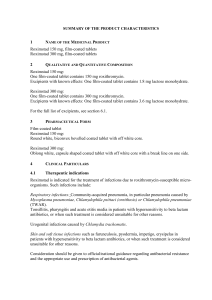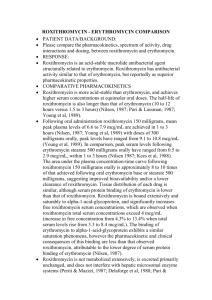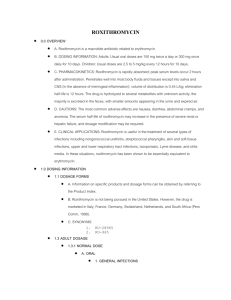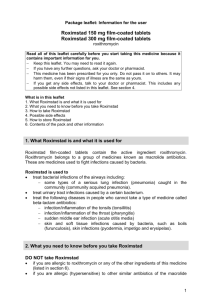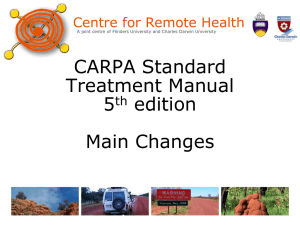Roxithromycin Sandoz film
advertisement
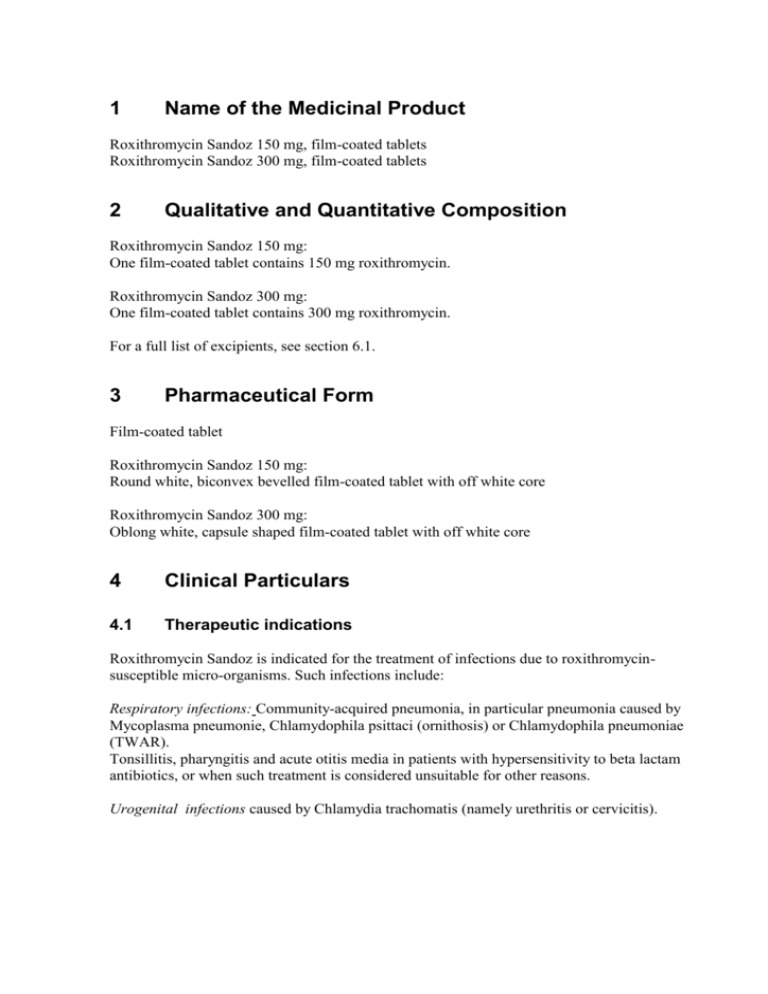
1 Name of the Medicinal Product Roxithromycin Sandoz 150 mg, film-coated tablets Roxithromycin Sandoz 300 mg, film-coated tablets 2 Qualitative and Quantitative Composition Roxithromycin Sandoz 150 mg: One film-coated tablet contains 150 mg roxithromycin. Roxithromycin Sandoz 300 mg: One film-coated tablet contains 300 mg roxithromycin. For a full list of excipients, see section 6.1. 3 Pharmaceutical Form Film-coated tablet Roxithromycin Sandoz 150 mg: Round white, biconvex bevelled film-coated tablet with off white core Roxithromycin Sandoz 300 mg: Oblong white, capsule shaped film-coated tablet with off white core 4 Clinical Particulars 4.1 Therapeutic indications Roxithromycin Sandoz is indicated for the treatment of infections due to roxithromycinsusceptible micro-organisms. Such infections include: Respiratory infections: Community-acquired pneumonia, in particular pneumonia caused by Mycoplasma pneumonie, Chlamydophila psittaci (ornithosis) or Chlamydophila pneumoniae (TWAR). Tonsillitis, pharyngitis and acute otitis media in patients with hypersensitivity to beta lactam antibiotics, or when such treatment is considered unsuitable for other reasons. Urogenital infections caused by Chlamydia trachomatis (namely urethritis or cervicitis). Skin and soft tissue infections such as furunculosis, pyodermia, impetigo, erysipelas in patients with hypersensitivity to beta lactam antibiotics, or when such treatment is considered unsuitable for other reasons. Consideration should be given to official/national guidance regarding antibacterial resistance and the appropriate use and prescription of antibacterial agents. 4.2 Posology and method of administration The tablet should be taken at least 15 minutes before a meal. Normal dosage is 150 mg twice daily (every 12th hour). Patients with pneumonia may be treated with the dosage regimen 300 mg once daily. Dosage in renal insufficiency: In patients with renal insufficiency no change in dosage is necessary (see section 5.2). Dosage in liver insufficiency: Roxithromycin Sandoz 150 mg bid (and 300 mg) are not recommended in patients with severe hepatic insufficiency (see section 4.4). If use of roxithromycin is essential because of clinical reasons in this patient group, half of the usual dose a day (= 150 mg) may be administered. Roxithromycin should be used with caution in subjects with mild to moderate hepatic insufficiency (see section 4.4). Elderly patients: No change in dosage is necessary. Paediatric patients: In children with a body weight of more than 40 kg the dosage should be the same as in adults. In children with a body weight of less than 40 kg, roxithromycin is not recommended. Roxithromycin Sandoz tablets are not suitable for administration to children under 6 years, for whom other pharmaceutical forms are available. Duration of treatment: As a rule Roxithromycin Sandoz is administered for a further 3 or 4 days after improvement of the clinical symptoms. Therapy over at least 10 days is indicated in the treatment of infections with ß-haemolytic streptococci in order to prevent late complications (e.g. rheumatic fever, glomerulonephritis). 4.3 Contraindications Known hypersensitivity to macrolides or to any of the excipients. Concomitant administration of roxithromycin and any of the following substances is contraindicated: cisapride, ergot alkaloid derivatives (such as ergotamine and dihydroergotamine), pimozide, astemizole and terfenadine (see section 4.4 and 4.5). Roxithromycin is contraindicated in patients with a history of congenital or a family history of long QT syndrome (if not excluded by ECG) and in patients with known acquired QT interval prolongation (see also section 4.4). 4.4 Special warnings and special precautions for use As with other macrolides, due to a potential to increase QT interval, roxithromycin should be used with care in patients with coronary heart disease, a history of ventricular arrhythmias, uncorrected hypokalaemia and/or hypomagnesaemia, bradycardia (<50 bpm), or during concomitant administration of roxithromycin with QT interval prolonging agents or potent CYP 3A4 inhibitors such as protease inhibitors and ketoconazole. The use of roxithromycin is not recommended in patients with severe hepatic insufficiency (e.g. cirrhosis of the liver with hepatitis and/or ascites). If use of roxithromycin is essential because of clinical reasons in this patient group please refer for dosage to section 4.2. Parameters of hepatic function must be controlled regularly in patients with signs of liver dysfunction or in case hepatic functional impairment has occurred on previous therapy with roxithromycin. If the parameters deteriorate during administration of roxithromycin i.e. increase in liver enzymes and/or bilirubin (jaundice), discontinuation of therapy should be considered. In case of severe and persistent diarrhoea, the possibility of pseudo-membranous colitis must be considered and if not refuted, roxithromycin therapy should be discontinued. Antiperistaltics are contraindicated. Anaphylactic reactions including angioedema have been reported for roxithromycin. Anaphylactic reactions can progress to a life threatening shock, even after the first administration. In these cases roxithromycin should be discontinued and suitable treatment (e.g. treatment for shock) initiated. Roxithromycin has been shown to prolong the QT interval on the electrocardiogram in some patients and to cause ventricular tachycardia (e.g. torsade de pointes). If signs of cardiac arrhythmia occur during treatment with roxithromycin, treatment should be stopped and an ECG should be performed. As with other macrolide antibiotics, roxithromycin may exacerbate or aggravate myasthenia gravis. Patients with myasthenia gravis taking roxithromycin should be advised to immediately seek medical attention if they experience exacerbation of their symptoms. Roxithromycin must then be discontinued and supportive care administered as medically indicated. The effects of the medicinal product in children have not been documented. Roxithromycin Sandoz is not intended for use in children and patients with a body weight of less than 40 kg. During therapy exceeding a period of 14 days, routine kidney, liver and blood laboratory tests should be performed regularly. This medicinal product contains lactose. Patients with rare hereditary problems of galactose intolerance, the Lapp lactase deficiency or glucose-galactose malabsorption should not take this medicine. 4.5 Interaction with other medicinal products and other forms of interaction CYP3A4 substrates Roxithromycin is a weak inhibitor of CYP3A4, increasing midazolam AUC by 47%. A possible clinical relevant inhibition of CYP3A4, leading to increased exposure of concomitantly administered medicines that are substrates of this enzyme, cannot be excluded in some individuals. Therefore, co-administration of cisapride, ergot alkaloid derivatives, pimozide, astemizole and terfenadine is contraindicated, and caution is warranted when roxithromycin is co-administered with other medicinal products with narrow therapeutic window metabolised by CYP3A4. Astemizole/Cisapride/Pimozide Co-administration of roxithromycin with astemizole, cisapride, or pimozide may result in increased serum concentrations of these agents. Elevated serum levels of these agents have been associated with adverse cardiovascular effects such as QT interval prolongation and cardiac arrhythmia. Concomitant use of these substances with roxithromycin is therefore contra-indicated (see section 4.3). Terfenadine Some macrolides interact with terfenadine, with increased serum concentration of terfenadine as a consequence. This may cause serious ventricular arrythmia, such as Torsade de pointes. Although this kind of reaction has not been demonstrated with roxithromycin and studies with a limited number of healthy volunteers have shown no pharmacokinetic interaction or relevant ECG-changes, the combination of roxithromycin and terfenadine is contra-indicated (see section 4.3). Ergot alkaloids Concomitant medication of roxithromycin and ergot alkaloid derivatives (such as ergotamine and dihydroergotamine) could lead to severe vasoconstriction (“ergotism”) with possibly necrosis of the extremities. The combination is contraindicated (see section 4.3). Cyclosporine Concomitant administration of roxithromycin and cyclosporine may result in an increase of cyclosporine concentrations. Cyclosporine dosage adjustment is in general not necessary. Midazolam Co-administration of roxithromycin (300 mg daily) and midazolam (15 mg orally) increased the midazolam (a sensitive CYP3A4 substrate) AUC by 47%, which may lead to enhanced midazolam effects. Anticoagulantia No interaction with warfarin has been found in studies of healthy volunteers, however, increases in prothrombin time or International Normalised Ratio (INR), which may be explained either as an interaction with roxithromycin or by the infectious episode (per se), have been reported in patients treated with roxithromycin and vitamin K antagonists. It is prudent practice to monitor INR during combined treatment with roxithromycin and vitamin K antagonists. Contraceptives Some antibiotics could in rare cases decrease the effect of oral contraceptives by interference with the bacterial hydrolysis of steroid conjugates in the intestine, thereby reducing the reabsorption of unconjugated steroid. The plasma levels of active steroid may then decrease. This rare interaction could occur in women with high biliary elimination of steroid conjugates. About 60 pregnancies have occurred in English women on oral contraceptives when antibiotics have been taken concomitantly, in particular ampicillin, amoxicillin and tetracyclines. There are negative studies with trimethoprim-sulphamethoxazole, roxithromycin and clarithromycin although in very few subjects. Digoxin and other cardiac glycosides Roxithromycin may increase the absorption of digoxin. A similar phenomenon has been described for other macrolides. Patients treated with roxithromycin and digoxin or any other cardiac glycoside should therefore be monitored by ECG and the serum level of the cardiac glycoside should be controlled. Disopyramide An in-vitro study has shown that roxithromycin can displace protein bound disopyramide. Such an effect in vivo may result in increased serum levels of free disopyramide. Therefore the ECG and, if possible, the serum levels of disopyramide should be controlled. Theophylline Roxithromycin use in patients who are receiving high doses of theophylline may be associated with an increase in serum theophylline levels and potentiate theophylline toxicity. Therapeutic drug monitoring of theophylline concentrations is recommended, especially when pretreatment levels of theophylline are higher than 15 µg/ml. 4.6 Pregnancy and lactation Pregnancy: There are no adequate data from the use of roxithromycin in pregnant women. No teratogenic or foetotoxic effects have been reported in animal studies. Roxithromycin should not be used during pregnancy unless clearly indicated. Lactation: There is no clinical experience on use during lactation. Only very small amounts of roxithromycin (less than 0.05% of the dose taken) are excreted into maternal milk. Roxithromycin should be given during lactation only when clearly indicated. 4.7 Effects on ability to drive and use machines Car drivers and machine users should be informed about the risk of dizziness. 4.8 Undesirable effects The total frequency of side effects is about 4% (150 mg x 2) and 10% (300 mg x 1) respectively. 3% and 7% respectively are gastrointestinal side effects, i.e. the frequency is increased with dosing once daily. Adverse reactions are listed below by system organ class and frequency. Frequencies are defined as: Very common (1/10) Common (1/100 to <1/10) Uncommon (1/1000 to 1/100) Rare (1/10000 to 1/1000) Very rare (1/10000) Not known (can not be estimated from the available data). Common Infections and infestations Blood and lymphatic system disorders Immune system disorders Uncommon Rare Not known (Post-marketing experiences) super infections with resistant bacteria or fungi on long-term use, pseudo membranous colitis (see section 4.4) Changes in blood Thrombocytopenia count Angiooedema Anaphylactic reaction (see section 4.4) Psychiatric disorders Nervous system disorders Headache Dizziness Eye disorders Ear and labyrinth disorders Cardiac disorders Respiratory, thoracic and mediastinal disorders Gastroinstes tinal disorders Hepatobiliar y disorders Skin and subcutaneou s tissue disorders Musculoske letal and connective tissue disorder Taste disorders (incl. aguesia) Smell disorders (incl. anosmia) Confusion, hallucination, psychosis Paresthesia Visual disturbance Tinnitus QT-prolongation, ventricular tachycardia and torsade de pointes (see section 4.4). Bronchospasm Nausea Epigastric pain Dyspepsia Vomiting Obstipation Flatulence Diarrhoea (see section 4.4) Increased transaminases and/or alkaline phosphatases and/or bilirubin (see section 4.4) Redness Rash Urticaria Anorexia Cholestatic hepatitis, hepatocellular acute hepatitis (see section 4.4) Pancreatitis Jaundice (see section 4.4) Eczema Pruritus, epidermal toxic necrolysis, StevensJohnson syndrome and erythema multiforme Myasthenia gravis (see section 4.4) General disorders and administrati on site conditions 4.9 Weakness Discomfort Overdose Toxicity: Low acute toxicity, but there is limited experience of overdose. Symptoms: Nausea, vomiting and diarrhoea. Undesirable effects such as headache and dizziness may appear and become potentiated by overdose. Treatment: In the event of an overdose, the stomach should be emptied by gastric lavage and the patients should be treated with active carbon and with an osmotic purgative. Further treatment is symptomatic. There is no specific antidote. 5 Pharmacological Properties 5.1 Pharmacodynamic properties General properties Pharmacotherapeutic group: Roxithromycin is a semi-synthetic macrolide with a 14membered lactone ring. ATC code J01FA06 Mode of action Roxithromycin’s mode of action is exerted by inhibiting protein synthesis through binding to the 50S subunit of the bacterial ribosome. The antibacterial effect results herefrom. PK/PD relationship Primarily, the efficacy of roxithromycin mainly depends on the time period, in which the serum level is above the Minimum Inhibitory Concentration (MIC) for the pathogen. Mechanisms of resistance Resistance against roxithromycin can be due to the following mechanisms: - Efflux: Increase in the number of efflux pumps in the cytoplasmic membrane can result in resistance. Only 14- and 15-membered lactone rings (M-phenotype) are affected by this. - Alteration of target structure: Methylation of the 23S rRNS decreases the affinity for ribosomal binding site. This results in resistance against macrolides (M), lincosamides (L) and streptogramin B (MLSB-phenotype). - The enzymatical deactivation of macrolides is only of secondary clinical relevance. Among M phenotype there is complete cross-resistance between roxithromycin, azithromycin, clarithromycin, and erythromycin, respectively. Among MLSB phenotype cross-resistance with clindamycin and streptogramin B exists additonally. Breakpoints: Minimum inhibitory concentration (MIC) breakpoint established by the European Committee on Antimicrobial Susceptibility Testing (EUCAST) are as follows: Staphylococcus spp. S ≤ 1.0 mg/L and R > 2.0 mg/L Streptococcus spp., group A, B, C and G S ≤ 0.5 mg/L and R > 1.0 mg/L Streptococcus pneumoniae S ≤ 0.5 mg/L and R > 1.0 mg/L Haemophilus influenzae* S ≤ 1.0 mg/L and R > 16 mg/L Moraxella catarrhalis S ≤ 0.5 mg/L and R > 1.0 mg/L * The correlation between H. influenzae macrolide MICs and clinical outcome is weak. Therefore, breakpoints for macrolides and related antibiotics were set to categorise wild type H. influenzae as intermediate Susceptibility: The prevalence of acquired resistance may vary geographically and with time for selected species. Therefore, local information on resistance is desirable, particularly when treating severe infections. As necessary, expert advice should be sought when the local prevalence of resistance is such that the utility of roxithromycin in at least some types of infections is questionable. Commonly susceptible species Aerobic Gram-positive micro-organisms Streptococcus pyogenes 1 Aerobic Gram-negative micro-organisms Moraxella catarrhalis Other microorganisms Chlamydia trachomatis Chlamydophila pneumoniae Chlamydophila psittaci Legionella pneumophila Mycoplasma pneumoniae Species for which acquired resistance may be a problem Aerobic Gram-positive micro-organisms Staphylococcus aureus (methicillinsusceptible) Staphylococcus aureus (methicillinresistent)+ Streptococcus pneumoniae Aerobic Gram-negative micro-organisms Haemophilus influenzae$ Inherently resistant organisms Aerobic Gram-negative micro-organisms Escherichia coli Klebsiella spp. Pseudomonas aeruginosa Other microorganisms Mycoplasma hominis $ Natural intermediate susceptibility. + 1 High rates of resistance (> 50%) have been observed in one or more regions within the EU. Resistance rate in some studies 10% 5.2 Pharmacokinetic properties Absorption: For maximal absorption the tablet should be taken at least 15 minutes before a meal. Roxithromycin displays non-linear kinetics, and AUC and Cmax do not increase in proportion to dose. Following singles doses of 150 mg and 300 mg to healthy volunteers mean Cmax values were in the range of 5.8 – 10.1 µg/ml and 7.2 – 12.0 µg/ml, respectively; under multiple dosing for up to 15 days there is marginal accumulation with mean Cmax values of 6.57 – 9.3 µg/ml (150 mg) and 10.4 – 10.9 µg/ml (300 mg). Maximum plasma concentration is reached after about 1-2 hours. The binding to plasma proteins at clinically relevant concentrations is 80-96%. Roxithromycin binds with high affinity mainly to acid alpha-1-glycoproteins (saturated binding) and with low affinity to albumin (unsaturated binding): The binding is concentration dependent at concentrations above 4 mg/ml. Distribution: Roxithromycin exhibits good penetration into various tissues and body fluids. High tissue concentrations have been observed in lungs, tonsils, sinus mucosa, prostate and uterus, 6 and 12 hours after administration in multiple dose studies. Roxithromycin accumulates into macrophages and polymorphonuclear neutrophils; intracellular/extracellular concentration ratios range from 14 to 190. The passage over the blood-brain-barrier is limited. The half-life following single doses is reported to range from 6.3-16 h at doses of 150-450 mg. Following multiple dosing the half-life is reported to be 12-13 h, resulting in therapeutic plasma concentrations at the recommended dosages. Biotransformation and elimination: More than half of the administered dose is excreted unchanged. Roxithromycin is mainly metabolised by the liver. Three metabolites have been identified in faeces and urine; descladinose roxithromycin, N-monodemethylroxithromycin and N-dimethylroxithromycin. After oral dosage, roxithromycin is mainly eliminated in faeces and partly by the lungs. Only a small part of the dose is excreted in the urine. The dose should therefore be kept unchanged for patients with renal insufficiency. Special populations In patients with impaired liver function, the half life can be prolonged to about 25 hours and Cmax increases after an oral dosage of 150 mg (see section 4.2). In end-stage renal disease Cmax was not altered as compared to healthy subjects. In infants or children receiving roxithromycin 2.5 mg/kg bid for 6 days mean Cmax values were 10.1 µg/ml (5 – 13 months of age), 8.7 µg/ml (2 – 4 years of age), and 8.8 µg/ml (5 – 12 years of age), respectively. The plasma half-life of roxithromycin is increased in eldery patients. However, AUC and maximal concentrations after repeated dosing are only moderately increased compared to younger patients. Hence no dosage adjustment is necessary. 5.3 Preclinical safety data Roxithromycin, like erythromycin, has been shown in vitro to cause a concentrationdependent QRS prolongation. Such effects have not been seen in humans, but have been regarded as possible in clinical use. There are no other preclinical data concerning general toxicity, reproduction effects and genotoxicity, relevant for the prescriber, except those already included under other headings in the summary of product characteristics. 6 Pharmaceutical Particulars 6.1 List of excipients Core: microcrystalline cellulose, colloidal anhydrous silica, croscarmellose sodium, polaxamer 188, povidone, talc, magnesium stearate. Coating: lactose monohydrate, hypromellose, macrogol 4000, titanium dioxide (E171) 6.2 Incompatibilities Not applicable 6.3 Shelf-life 3 years 6.4 Special precautions for storage No special requirements. 6.5 Nature and content of container Roxithromycin Sandoz, 150 mg: PVC/Aluminium blister: 5, 10, 12, 14, 15, 16, 20, 28, 30, 50, 60, 90, 100, 250 and 500 film-coated tablets Roxithromycin Sandoz, 300 mg: PVC/Aluminium blister: 5, 6, 7, 10, 14, 15, 16, 20, 28, 30, 50, 60, 90, 100, 250 and 500 film-coated tablets Not all pack sizes may be marketed. 6.6 Special precautions for disposal No special requirements 7 Marketing Authorisation Holder [To be completed nationally] 8 Marketing Authorisation Number(s) [To be completed nationally] 9 Date of First Authorisation/Renewal of the Authorisation Date of first authorisation: June 16, 2000 Date of latest renewal: June 16, 2010 10 Date of Revision of the Text May 19, 2010
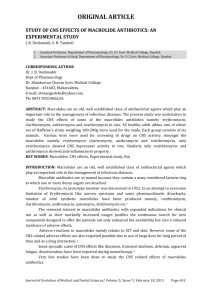
![njc34_4[^]](http://s3.studylib.net/store/data/007315276_1-991b477231a5bba08dd276919b6b9bbf-300x300.png)
